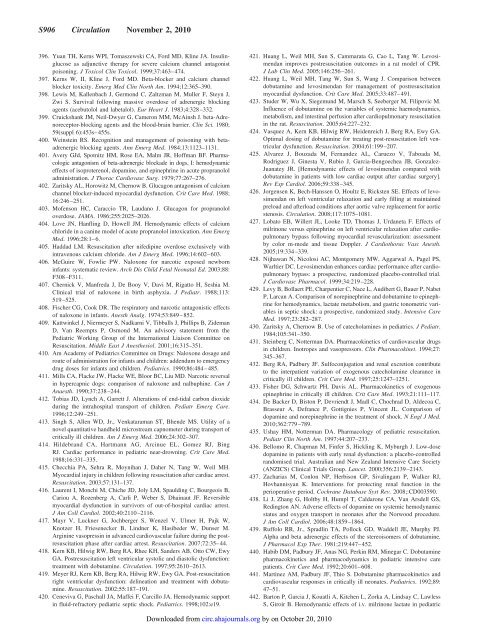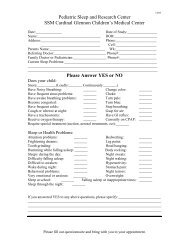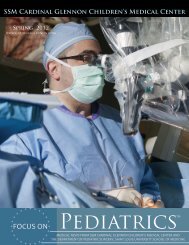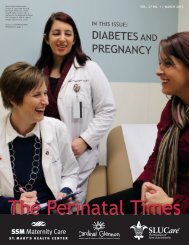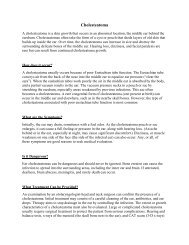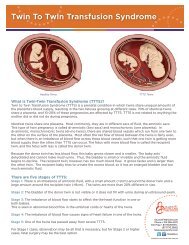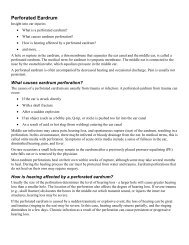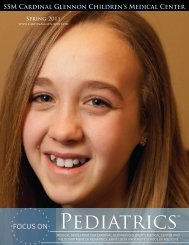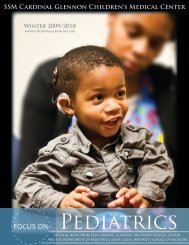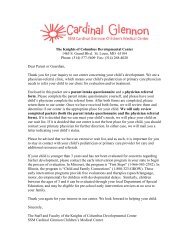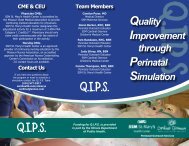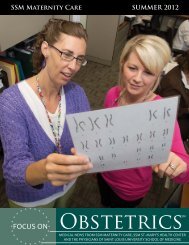pediatric-ALS-AHA-guidelines-circulation_11-2010 - SSM Cardinal ...
pediatric-ALS-AHA-guidelines-circulation_11-2010 - SSM Cardinal ...
pediatric-ALS-AHA-guidelines-circulation_11-2010 - SSM Cardinal ...
Create successful ePaper yourself
Turn your PDF publications into a flip-book with our unique Google optimized e-Paper software.
S906 Circulation November 2, <strong>2010</strong>396. Yuan TH, Kerns WPI, Tomaszewski CA, Ford MD, Kline JA. Insulinglucoseas adjunctive therapy for severe calcium channel antagonistpoisoning. J Toxicol Clin Toxicol. 1999;37:463–474.397. Kerns W, II, Kline J, Ford MD. Beta-blocker and calcium channelblocker toxicity. Emerg Med Clin North Am. 1994;12:365–390.398. Lewis M, Kallenbach J, Germond C, Zaltzman M, Muller F, Steyn J,Zwi S. Survival following massive overdose of adrenergic blockingagents (acebutolol and labetalol). Eur Heart J. 1983;4:328–332.399. Cruickshank JM, Neil-Dwyer G, Cameron MM, McAinsh J. beta-Adrenoreceptor-blockingagents and the blood-brain barrier. Clin Sci. 1980;59(suppl 6):453s–455s.400. Weinstein RS. Recognition and management of poisoning with betaadrenergicblocking agents. Ann Emerg Med. 1984;13:<strong>11</strong>23–<strong>11</strong>31.401. Avery GJd, Spotnitz HM, Rose EA, Malm JR, Hoffman BF. Pharmacologicantagonism of beta-adrenergic blockade in dogs, I: hemodynamiceffects of isoproterenol, dopamine, and epinephrine in acute propranololadministration. J Thorac Cardiovasc Surg. 1979;77:267–276.402. Zaritsky AL, Horowitz M, Chernow B. Glucagon antagonism of calciumchannel blocker-induced myocardial dysfunction. Crit Care Med. 1988;16:246–251.403. Mofenson HC, Caraccio TR, Laudano J. Glucagon for propranololoverdose. JAMA. 1986;255:2025–2026.404. Love JN, Hanfling D, Howell JM. Hemodynamic effects of calciumchloride in a canine model of acute propranolol intoxication. Ann EmergMed. 1996;28:1–6.405. Haddad LM. Resuscitation after nifedipine overdose exclusively withintravenous calcium chloride. Am J Emerg Med. 1996;14:602–603.406. McGuire W, Fowlie PW. Naloxone for narcotic exposed newborninfants: systematic review. Arch Dis Child Fetal Neonatal Ed. 2003;88:F308–F3<strong>11</strong>.407. Chernick V, Manfreda J, De Booy V, Davi M, Rigatto H, Seshia M.Clinical trial of naloxone in birth asphyxia. J Pediatr. 1988;<strong>11</strong>3:519–525.408. Fischer CG, Cook DR. The respiratory and narcotic antagonistic effectsof naloxone in infants. Anesth Analg. 1974;53:849–852.409. Kattwinkel J, Niermeyer S, Nadkarni V, Tibballs J, Phillips B, ZidemanD, Van Reempts P, Osmond M. An advisory statement from thePediatric Working Group of the International Liaison Committee onResuscitation. Middle East J Anesthesiol. 2001;16:315–351.410. Am Academy of Pediatrics Committee on Drugs: Naloxone dosage androute of administration for infants and children: addendum to emergencydrug doses for infants and children. Pediatrics. 1990;86:484–485.4<strong>11</strong>. Mills CA, Flacke JW, Flacke WE, Bloor BC, Liu MD. Narcotic reversalin hypercapnic dogs: comparison of naloxone and nalbuphine. Can JAnaesth. 1990;37:238–244.412. Tobias JD, Lynch A, Garrett J. Alterations of end-tidal carbon dioxideduring the intrahospital transport of children. Pediatr Emerg Care.1996;12:249–251.413. Singh S, Allen WD, Jr., Venkataraman ST, Bhende MS. Utility of anovel quantitative handheld microstream capnometer during transport ofcritically ill children. Am J Emerg Med. 2006;24:302–307.414. Hildebrand CA, Hartmann AG, Arcinue EL, Gomez RJ, BingRJ. Cardiac performance in <strong>pediatric</strong> near-drowning. Crit Care Med.1988;16:331–335.415. Checchia PA, Sehra R, Moynihan J, Daher N, Tang W, Weil MH.Myocardial injury in children following resuscitation after cardiac arrest.Resuscitation. 2003;57:131–137.416. Laurent I, Monchi M, Chiche JD, Joly LM, Spaulding C, Bourgeois B,Cariou A, Rozenberg A, Carli P, Weber S, Dhainaut JF. Reversiblemyocardial dysfunction in survivors of out-of-hospital cardiac arrest.J Am Coll Cardiol. 2002;40:2<strong>11</strong>0–2<strong>11</strong>6.417. Mayr V, Luckner G, Jochberger S, Wenzel V, Ulmer H, Pajk W,Knotzer H, Friesenecker B, Lindner K, Hasibeder W, Dunser M.Arginine vasopressin in advanced cardiovascular failure during the postresuscitationphase after cardiac arrest. Resuscitation. 2007;72:35–44.418. Kern KB, Hilwig RW, Berg RA, Rhee KH, Sanders AB, Otto CW, EwyGA. Postresuscitation left ventricular systolic and diastolic dysfunction:treatment with dobutamine. Circulation. 1997;95:2610–2613.419. Meyer RJ, Kern KB, Berg RA, Hilwig RW, Ewy GA. Post-resuscitationright ventricular dysfunction: delineation and treatment with dobutamine.Resuscitation. 2002;55:187–191.420. Ceneviva G, Paschall JA, Maffei F, Carcillo JA. Hemodynamic supportin fluid-refractory <strong>pediatric</strong> septic shock. Pediatrics. 1998;102:e19.421. Huang L, Weil MH, Sun S, Cammarata G, Cao L, Tang W. Levosimendanimproves postresuscitation outcomes in a rat model of CPR.J Lab Clin Med. 2005;146:256–261.422. Huang L, Weil MH, Tang W, Sun S, Wang J. Comparison betweendobutamine and levosimendan for management of postresuscitationmyocardial dysfunction. Crit Care Med. 2005;33:487–491.423. Studer W, Wu X, Siegemund M, Marsch S, Seeberger M, Filipovic M.Influence of dobutamine on the variables of systemic haemodynamics,metabolism, and intestinal perfusion after cardiopulmonary resuscitationin the rat. Resuscitation. 2005;64:227–232.424. Vasquez A, Kern KB, Hilwig RW, Heidenreich J, Berg RA, Ewy GA.Optimal dosing of dobutamine for treating post-resuscitation left ventriculardysfunction. Resuscitation. 2004;61:199–207.425. Alvarez J, Bouzada M, Fernandez AL, Caruezo V, Taboada M,Rodriguez J, Ginesta V, Rubio J, Garcia-Bengoechea JB, Gonzalez-Juanatey JR. [Hemodynamic effects of levosimendan compared withdobutamine in patients with low cardiac output after cardiac surgery].Rev Esp Cardiol. 2006;59:338–345.426. Jorgensen K, Bech-Hanssen O, Houltz E, Ricksten SE. Effects of levosimendanon left ventricular relaxation and early filling at maintainedpreload and afterload conditions after aortic valve replacement for aorticstenosis. Circulation. 2008;<strong>11</strong>7:1075–1081.427. Lobato EB, Willert JL, Looke TD, Thomas J, Urdaneta F. Effects ofmilrinone versus epinephrine on left ventricular relaxation after cardiopulmonarybypass following myocardial revascularization: assessmentby color m-mode and tissue Doppler. J Cardiothorac Vasc Anesth.2005;19:334–339.428. Nijhawan N, Nicolosi AC, Montgomery MW, Aggarwal A, Pagel PS,Warltier DC. Levosimendan enhances cardiac performance after cardiopulmonarybypass: a prospective, randomized placebo-controlled trial.J Cardiovasc Pharmacol. 1999;34:219–228.429. Levy B, Bollaert PE, Charpentier C, Nace L, Audibert G, Bauer P, NabetP, Larcan A. Comparison of norepinephrine and dobutamine to epinephrinefor hemodynamics, lactate metabolism, and gastric tonometric variablesin septic shock: a prospective, randomized study. Intensive CareMed. 1997;23:282–287.430. Zaritsky A, Chernow B. Use of catecholamines in <strong>pediatric</strong>s. J Pediatr.1984;105:341–350.431. Steinberg C, Notterman DA. Pharmacokinetics of cardiovascular drugsin children. Inotropes and vasopressors. Clin Pharmacokinet. 1994;27:345–367.432. Berg RA, Padbury JF. Sulfoconjugation and renal excretion contributeto the interpatient variation of exogenous catecholamine clearance incritically ill children. Crit Care Med. 1997;25:1247–1251.433. Fisher DG, Schwartz PH, Davis AL. Pharmacokinetics of exogenousepinephrine in critically ill children. Crit Care Med. 1993;21:<strong>11</strong>1–<strong>11</strong>7.434. De Backer D, Biston P, Devriendt J, Madl C, Chochrad D, Aldecoa C,Brasseur A, Defrance P, Gottignies P, Vincent JL. Comparison ofdopamine and norepinephrine in the treatment of shock. N Engl J Med.<strong>2010</strong>;362:779–789.435. Ushay HM, Notterman DA. Pharmacology of <strong>pediatric</strong> resuscitation.Pediatr Clin North Am. 1997;44:207–233.436. Bellomo R, Chapman M, Finfer S, Hickling K, Myburgh J. Low-dosedopamine in patients with early renal dysfunction: a placebo-controlledrandomised trial. Australian and New Zealand Intensive Care Society(ANZICS) Clinical Trials Group. Lancet. 2000;356:2139–2143.437. Zacharias M, Conlon NP, Herbison GP, Sivalingam P, Walker RJ,Hovhannisyan K. Interventions for protecting renal function in theperioperative period. Cochrane Database Syst Rev. 2008;:CD003590.438. Li J, Zhang G, Holtby H, Humpl T, Caldarone CA, Van Arsdell GS,Redington AN. Adverse effects of dopamine on systemic hemodynamicstatus and oxygen transport in neonates after the Norwood procedure.J Am Coll Cardiol. 2006;48:1859–1864.439. Ruffolo RR, Jr., Spradlin TA, Pollock GD, Waddell JE, Murphy PJ.Alpha and beta adrenergic effects of the stereoisomers of dobutamine.J Pharmacol Exp Ther. 1981;219:447–452.440. Habib DM, Padbury JF, Anas NG, Perkin RM, Minegar C. Dobutaminepharmacokinetics and pharmacodynamics in <strong>pediatric</strong> intensive carepatients. Crit Care Med. 1992;20:601–608.441. Martinez AM, Padbury JF, Thio S. Dobutamine pharmacokinetics andcardiovascular responses in critically ill neonates. Pediatrics. 1992;89:47–51.442. Barton P, Garcia J, Kouatli A, Kitchen L, Zorka A, Lindsay C, LawlessS, Giroir B. Hemodynamic effects of i.v. milrinone lactate in <strong>pediatric</strong>Downloaded from circ.ahajournals.org by on October 20, <strong>2010</strong>


